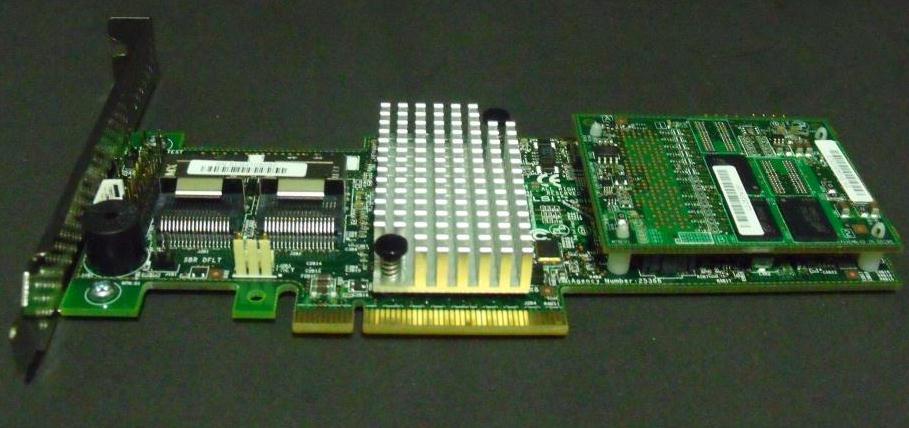Following our reviews of the Areca 1880 RAID Card and LSI 9260-8i MegaRAID Card, we are going to evaluate the LSI 9265-8i MegaRAID Card, an eight-port PCI Express SATA+SAS RAID Controller that is configured for 6Gb/s devices. With the speed and power of SSDs reinventing mainstream storage, RAID card manufacturers are challenged to deliver a product that can handle the massive throughput and high random reads of these solid state drives.
Manufacturers then raise the bar by combining these SSDs into ultra speedy RAID arrays, the end result of which is shown in the LSI 9265-8i as we have today.
THE LSI CHALLENGE TO IMPROVE
The SSD has literally been a ‘game changer’ for the world of storage and LSI first began to address this issue with the highly successful 9260 series of cards, these having sold 400,000 cards worldwide. At the heart of the MegaRAID series is the LSI 2108 ROC controller (and other iterations), which have proven to be the key to LSI’ success.
These ROC controllers are now used by several vendors, which include IBM and Intel. Currently no company is able to provide the computational power to handle such heavy loads outside of LSI, LSI being a company presently enjoying a 3x performance lead over their nearest rivals in this realm. It seems that the only company that seems to be able to challenge LSI, is LSI itself, and they have returned with the 9265-8i, a card which raises the bar on storage performance to even higher levels!
- Ability to achieve 465,000 IOPS with a single controller
- 4x IOPS performance advantage over the closest competitor
- 3x greater IOPS than LSIs 1st generation 6Gb/s controllers
- 10x greater IOPS than todays 3Gb/s controllers
- 67% improvement in RAID 5 & 6 sequential writes (up to 2600 MB/s)
These are just a few of the selling points of the 9265 MegaRAID card, whose controller boasts a new ROC, the LSISAS2208 Dual- core 6Gb/s ROC- x2 800MHz PowerPC Processor. This ‘engine’ is key to its performance, it leverages the increased throughput of the x8 PCI Express 2.0 host interface for higher throughput and ease of connection. Even this bus is proving to be ‘squeezed’ here by the sheer power of this card.
Another big step forward is the expansion into DDR3 cache running at 1333MHz, this being the first available controller to use this speed of cache, with previous generations using DDR2 800 MHz. This will enable faster write performance on the controller in certain scenarios. The raid card provides a plethora of connectivity for all of your storage needs, fully supporting all speeds of SAS and SATA, all the way up to 6Gb/s!
SPECIFICATIONS
Features
- Eight internal SATA+SAS ports
- Two mini-SAS SFF-8087 x4 connectors
- 6Gb/s throughput per port LSISAS2208
- Dual Core ROC
– 800MHz PowerPC® MD2 - Low profile (6.6″ X 2.536″)
- x8 PCI Express 2.0 host interface
- 1GB DDRIII cache (1333MHz)
- Optional battery backup unit (LSIiBBU09 remote mount)
- Connect up to 128 SATA and/or SAS devices
- RAID levels 0, 1, 5 and 6
- RAID spans 10, 50 and 60
- Auto-resume on rebuild
- Auto-resume on reconstruction
- Online Capacity Expansion (OCE)
- Online RAID Level Migration (RLM)
- SSD support with SSD Guard
- Global and dedicated hot spare with revertible hot spare support
– Automatic rebuild
– Enclosure affinity
– Emergency SATA hot spare for SAS arrays - Single controller multipathing (failover) I/O load balancing
- Comprehensive RAID management suite
Benefits
- Second generation 6Gb/s SATA+SAS with unprecedented levels of performance
- Ideal for internal storage environments using up to 128 SAS, SATA and solid state drives (SSDs)
- Unsurpassed IOPs performance and advanced software options help users realize full benefits of SSD deployments
- Meets high I/O transaction demands of database and datacenter applications
- Provides the sustained data transfer rates and high sequential bandwidth to meet processing requirements of digital media, video and imaging environments
LINKED INDEX
INTRODUCTION ~ EXTERNAL CHARACTERISTICS ~ BENCHMARK PREP
ATTO/CRYSTAL ~ AS SSD ~ HDTUNE PRO ~ WEI/AIDA ~ IOMETER
PASSMARK ~ VANTAGE ~ CONCLUSIONS AND THOUGHTS
If you want more detailed information on the testing, parameters and configurations used in testing, feel free to hit the forums! I will be happy to answer any questions, and as long as I have the hardware, if there is anything I have missed, I would be happy to run some tests for you and there will also be some more detailed presentations on 4k scaling for you enthusiasts out there 🙂 ~ Paul
 The SSD Review The Worlds Dedicated SSD Education and Review Resource |
The SSD Review The Worlds Dedicated SSD Education and Review Resource | 
